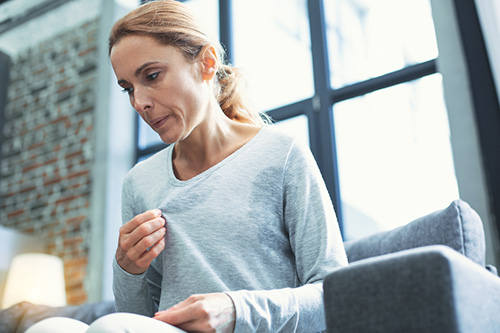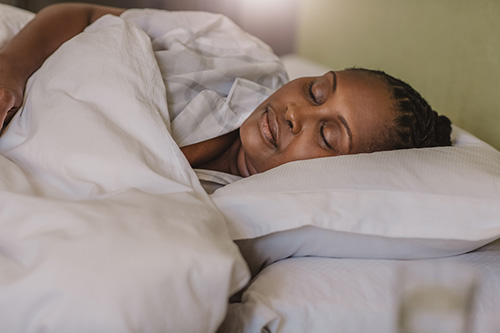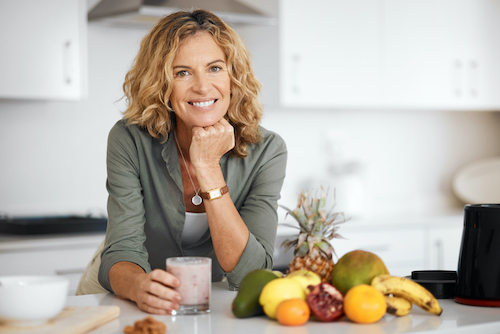PMS symptoms and causes
Premenstrual syndrome, or PMS, is one of the most common expressions of hormonal imbalance, affecting over half of all women — and there are a frighteningly large number of possible symptoms. And most women with PMS symptoms may be suffering in silence, worried that if they speak up, it might affect the way others see them in a negative way.
“I’d always had PMS symptoms — from moderate to extreme over the years. From acne to mood swings, depression, low energy, very sore breasts and, bloating, I felt like a victim when it came to my hormones. Now, I feel balanced and comfortable, and truly, my periods sneak up on me sometimes.”
Brooke, customer

While most of us are familiar with PMS, it is not well understood by conventional medicine, and is often either ignored or mistreated with prescription drugs meant for other issues. In addition, conventional medicine tends to focus only on temporarily smoothing over a few PMS symptoms rather than resolving the hormonal issues that are the true underlying cause.
Sensible natural options can offer lasting relief
While PMS can affect any woman who is having menstrual periods — from her first period on — it appears most often in adulthood. Women who experience PMS earlier in life are more predisposed to have a difficult perimenopause. But if PMS first occurs during your 40’s, it is often actually an early sign that you are entering perimenopause. Either way, the sooner you take action to stop your PMS symptoms, the better it will be for your body — now, and as you near menopause.
There is a tendency for PMS to worsen over time, and some women reach the point where they are symptom-free only a few days a month. Fortunately, most women can relieve their PMS symptoms. Many of the best options are natural approaches that target the root causes of PMS symptoms.
What causes PMS symptoms?
The most common symptoms of PMS can have a dramatic effect on your quality of life because they’re often physically uncomfortable and emotional disruptive. They can undermine your confidence and force you to make abrupt changes in your schedule. As with most aspects of health, the more information you have, the better the chance of finding the right solution for you.
Common symptoms of PMS
| Cramps or dysmenorrhea |
|---|
| Cause: Uterine contractions that follow hormone (prostaglandins) and chemical signals which trigger monthly shedding of the uterine lining (endometrium). Cramps may worsen as clots or tissue move through the cervix. Intense cramps may be the result of higher levels of prostaglandins in the endometrium.
Additional factors: Lack of exercise, emotional stress. What you can do today: Take a walk or practice yoga; have sex — orgasm is known to relieve cramps. |
| Bloating and/or an unpleasant, “tight” feeling in the abdomen |
|---|
| Cause: Fluid retained in response to monthly hormonal (progesterone) changes adding as much as an extra 5-6 pounds of weight, most of which is shed during menstruation.
Additional factors: Intake of salt, sugar, caffeine and alcohol, gas generated during digestive breakdown of certain foods, and imbalance of “good” bacteria in the gut. What you can do today: Cut down on salty foods, drink plenty of water and consider taking calcium, magnesium, and vitamins B6 and E. |
| Cravings |
|---|
| Cause: A chain reaction that starts with hormonal fluctuations linked to insulin levels and low blood sugar. This can trigger the brain to signal for more “fuel” which presents as intense urges for sweets and chocolate.
Additional factors: “Vicious cycle” effect — eating refined carbs leads to additional cravings for them. What you can do today: Increase intake of complex carbs such as whole grains to help stabilize blood sugar. |
| Breast tenderness |
|---|
| Cause: Hormonal fluctuations that trigger enlargement of the breast ducts and lobules (milk glands). In some women, breast swelling can limit their ability to function normally.
Additional factors: Family history, high-fat diet, and caffeine intake What you can do today: Energetic exercise every day is best; invest in a well-fitting bra, and reduce intake of fatty and salty foods. |
| Irritability, moodiness, and angry outbursts |
|---|
| Cause: Hormonal fluctuations and sensitivity to progesterone and low amounts of serotonin, the brain’s “happiness” neurotransmitter.
Additional factors: Stress, low levels of certain vitamins and minerals, alcohol and caffeine consumption. What you can do today: Exercise is a proven mood lifter and stress reliever which can make you much less irritable. |
| Anxiety, oversensitivity, and weepiness |
|---|
| Cause: Sensitivity to certain monthly hormone changes which may lead to the brain’s underuse of the neurotransmitter serotonin.
Additional factors: Stress, lack of sleep. What you can do today: Massage, progressive muscle relaxation, and deep breathing practices can reduce anxious feelings, as can attention to emotional wellness. |
| Adult acne |
|---|
| Cause: Hormonal imbalance and stress — especially if it is ongoing — and elevated cortisol levels sustained over long periods.
Additional factors: Stress, inflammation linked to diets high in sugar with very low antioxidant content. What you can do today: Use warm compresses to help soothe the areas where pimples are a problem, cleanse the skin gently and pat dry. Begin to adjust your diet to include plenty of fruits and vegetables. Avoid foods containing trans fats, such as processed snacks, crackers, cookies and chips. |
Your path to PMS relief
No matter what you’ve been told, you don’t have to just live with PMS. Your solution starts with providing a foundation of support that enables your body to make and balance its hormones as it is intended to do. Good nutrition and dietary supplements foster appropriate levels of hormones (especially progesterone) at key times throughout the month. In addition, you may want to explore any emotional concerns that are simmering beneath the surface.
It’s possible for you to change your monthly experience by using the information provided here to clear your own path to finding relief from PMS. Or you can make it easier by joining the women who find success by following our guided approach. It’s specifically structured to create the conditions for a healthy, comfortable menstrual cycle by providing support for your body throughout the month.










